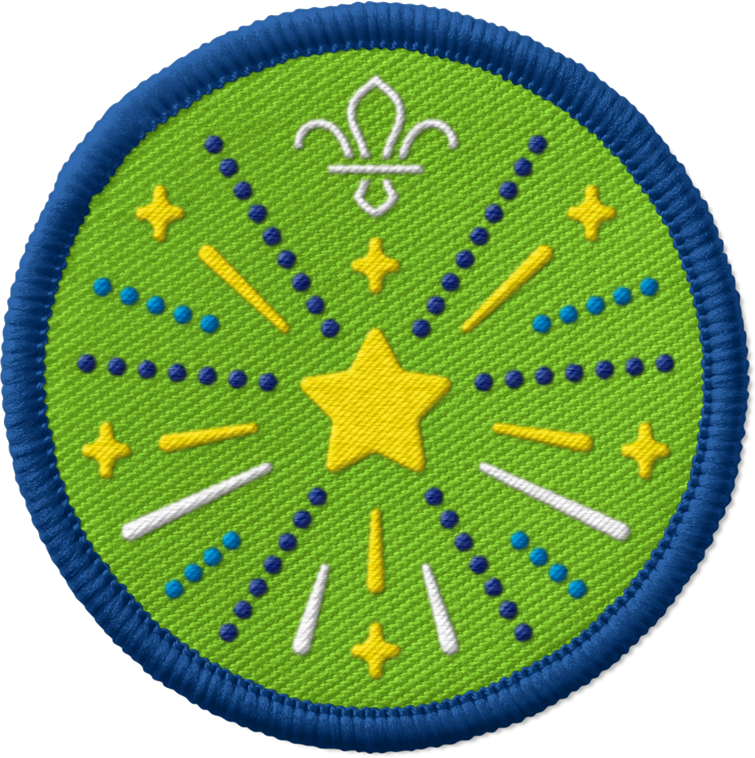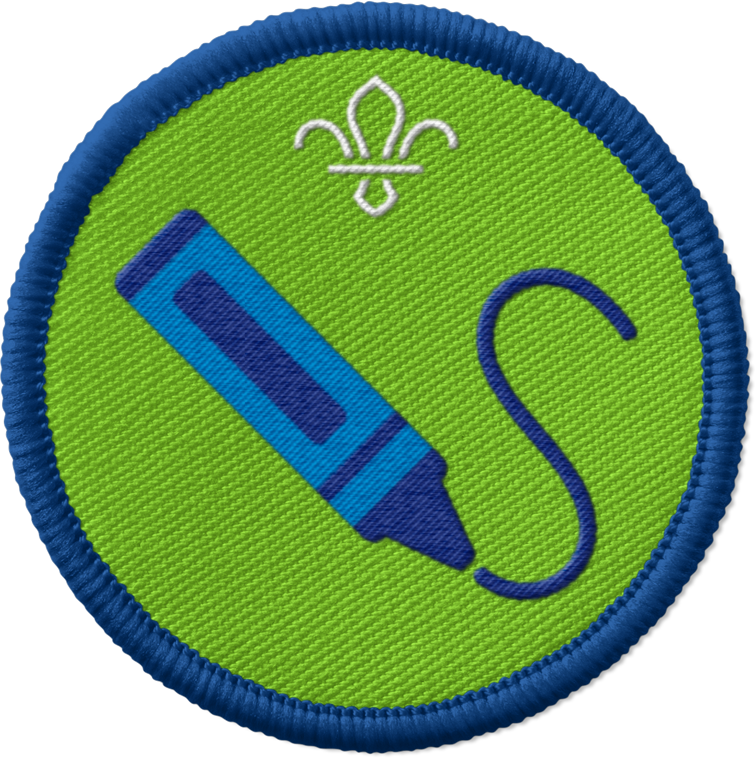Chinese window flowers
You’ll need
- Coloured pens or pencils
- Scissors
- Red paper
- String or thread
- Sticky tape
- Stapler (optional)
Before you begin
- Use the safety checklist to help you plan and risk assess your activity. Additional help to carry out your risk assessment, including examples can be found here. Don’t forget to make sure all young people and adults involved in the activity know how to take part safely.
- Make sure you’ll have enough adult helpers. You may need some parents and carers to help if you’re short on helpers.
Getting ready for the craft
- You could print some example templates, find some online, or even make your own.
- Choose craft paper for the group to use. Bear in mind that thinner paper will be easier to cut and delicate, while thicker paper or card will be harder to cut but less flimsy.
Paper cutting is an ancient form of artwork and decoration in China – the results are sometimes called ‘window flowers’.
They're really common around festivals. The paper cuttings are often glued to windows, so the light shines through them.
Chinese characters are often used to mark the decorations or as templates. There are some examples at the bottom of this page.
People celebrate lots of different festivals and events throughout the year in China. Paper cuttings are used throughout most of them as a low-cost decoration that looks great too!
Here are some common festivals that you can talk about as a group, or use as inspiration for your decorations:
Lunar New Year (also known as Chinese New Year)
- It's normally held between 25 January and 8 February.
- It's celebrated by putting up decorations, sharing food and gifts with family and friends, and setting off fireworks.
- Popular foods include fish dishes, filled dumplings and spring rolls, which are a symbol of wealth or good fortune.
- Mandarin oranges or tangerines are a symbol of good luck and may be served at the end of a meal or shared as gifts.
The Lantern Festival
- It's also known as the Yuan Xiao Festival.
- It aims to promote reconciliation, peace, and forgiveness.
- The holiday marks the first full moon of the new lunar year and the end of the Chinese New Year
- During the festival, houses are festooned with colourful lanterns, often with riddles written on them. If the riddle is answered correctly, the solver earns a small gift.
- Festival celebrations also include lion and dragon dances, parades, and fireworks.
Quinming festival
- Held around 4 April.
- An important day for showing respect to ancestors.
- Celebrated by upkeeping graves and tombs, giving offerings of food and drink, and spending time with family.
Dragon boat festival
- Held around 25 June.
- Based on legends of using dragon boats to find patriotic pet, Qu Yuan (343-278BC).
- Celebrated with dragon boat races and festival food, including Zongzi (sticky rice dumplings in pyramid shapes).
Dongzhi festival
- Held around 22 December.
- Marks the longest night of the year.
- Celebrated with warming food and drink such as filled dumplings and tangyuan. Try out our tangyuan recipe and try making your own.
You can find more information about all of these festivals on the China highlights website.
Create some window flowers
- Everyone should decide what they want to cut into their paper. They could do some research into Chinese paper cutting or festivals and celebrations to help them choose, or they could make it up their own design.
You can check out the festival information above, the paper cut examples below or find some others online.
- Everyone should prepare their template by drawing half of a symmetrical pattern on a piece of paper or card and cutting it out. Remember, they only need to create one half of their pattern because when they unfold the paper it’ll be mirrored.
- Take a piece of red paper and fold it in half. They should place the template on the paper so part of the design touches the folded edge and draw around it.
Unless part of the design touches the folded edge, the paper cutting will fall apart once it's unfolded.
- Remove their template and cut around the drawn outline. Then, they should unfold their paper and check out their masterpiece!
- Once everyone has finished their paper cuttings, they should get into small groups. Each group should stay socially distanced and find their own space.
- Take it in turns to show off their paper cuttings and tell everyone about the design they chose.
- Once everyone’s shared their creation, they should come back together and talk about anything and everything they know about Chinese festivals and celebrations. Has anyone heard of or celebrated any of these festivals before? Are there any they would want to try?
- To finish, you could use the paper cuttings to decorate your meeting place, or everyone could them home to hang in their windows. They’re a great conversation starter – you could explain why you made them and what you learned.
Examples of paper cut characters
Fu (福) means good fortune, blessing, and happiness. You'll see that many Chinese people put their 福 (fu) upside down on doors or windows.
The story is that one New Year's Day a long time ago, a family attached their 福 upside down by accident. On the first day of the new year, their first guest saw the upside down 福 and shouted "你们的福倒了!" (Your fu is upside down!). The Chinese word for 'upside down' is 倒 (dao), and it sounds the same as the word which means 'to arrive, 到 (dao).
When the guest shouted, "Your fu is upside down!" (你们的福倒了!) it sounded the same as, "Your fu has arrived!" (你们的福到了!). Everyone liked the alternative meaning so much that they started fixing their 福 decoration upside down to bring on blessings.
Follow the instructions below to make your own simple 福 paper cut:
- Start with a square piece of paper, place it on the table to that it’s in a diamond shape.
- Fold the paper in half by folding the left hand corner over to meet the corner on the right, creating a triangle shape.
- Fold the paper in half again, this time folding the corner at the bottom to meet the corner at the top.
- Fold it once more so that the corner at the top meets the corner on the right-hand side.
- Now, draw decorative patterns along the edge that isn’t folded.
- Use scissors to cut out your design, unfold the paper and check out the beautiful pattern!
- Place it on the table and rotate it by 45 degrees so it’s a diamond shape again.
- Next, use a pencil to draw the outline of the fu character, 福, in the centre.
- To finish, colour your character in black. You can attach a string to the top or simply hang it in the window or doorway.

The character 囍 is made from two copies of 喜 (xi). The character 喜 means joy, so the 囍 is known as double happiness! Typically the character 囍 is written in Chinese calligraphy, and is often used as a decoration for celebrations like weddings.
Follow the instructions below to make an easy 囍 paper cut:
- Start with a square piece of paper.
- Fold it in half by folding the left edge of the paper to meet the edge on the right.
- Repeat step two again, so you end up with a long, thin, folded piece of paper.
- With the fold on the left-hand side, trace out the pattern below. It’s a good idea to mark the areas you need to cut out so that you don’t make any mistakes.
- Cut out your pattern, and then unfold your paper to reveal the double happiness character.
- Attach some string to hang your paper cutting, or simply attach it to a window or door as it is.

Lunar/Chinese New Year is also known as the Spring Festival. It marks the end of the winter and the beginning of spring.
Decorating with paper-cuts has been a way to welcome spring since ancient times in China. In many areas, people like to paste paper-cuts with the word 春 (spring) on the window to express their happiness.
For more of a challenge, follow the instructions below to make your own 春 paper cut:
- Start with a square piece of paper.
- Fold it in half so that opposite corners meet and you make a triangle shape. Unfold the paper back into a square and repeat the fold so that the other two corners meet.
- Next, turn the paper over and fold it in half again. This time, folding so that the left-hand edge meets the right-hand edge and you make a rectangle shape. Unfold it back into a square and then fold it in half a final time so that the top edge meets the bottom edge.
- Now you’ve folded your guidelines, cross-fold the rice line and shrink it into a square.
- Finally, place your small square on the table with the point at the top. Fold it into a small triangle by folding the left hand corner over to meet the right.
- Draw your spring character pattern – remember you should only trace half of the character onto the triangle so that when you unfold the paper you’ll see the full character.
- You could use a clip to hold the paper together while you draw and cut. It’s a good idea to mark the areas you need to cut out so that you don’t make any mistakes.
- When you’ve finished drawing, use some scissors to cut your paper. Hold the top point of the triangle and unfold your paper.
- Use a needle to pass some red thread through the centre of the top of your papercut and glue it in place.
- To finish, glue the inside edges of your paper cut to hold it in shape and it’s ready to hang!
For an easier version of the spring papercut, simply take a sheet of paper and fold it in half. Trace half of the character onto one side, cut it out and unfold the paper. You’ve now got a papercut ready to hang in your window or door!

Reflection
People have been doing Jianzhi (剪紙), the Chinese art of papercutting, for 1,500 years. They’re typically used to decorate gates and windows – the paper’s often red, and the designs cut into it provide wishes of good health, financial security and a long life.
Studies have shown that both creating and observing art can reduce stress levels, making people happier. Why do people think that is? People could think about how art is a chance to express feelings openly and clearly or how creating art can be a form of mindfulness.
Can anyone think of an art form that makes them feel happier? Perhaps some people love a particular genre of music or playing an instrument, while others like to get stuck into writing, reading, drawing, painting, or trying something new like jianzhi.
Safety
All activities must be safely managed. You must complete a thorough risk assessment and take appropriate steps to reduce risk. Use the safety checklist to help you plan and risk assess your activity. Always get approval for the activity, and have suitable supervision and an InTouch process.
- Scissors
Supervise young people appropriately when they’re using scissors. Store all sharp objects securely, out of the reach of young people.
- Sharp objects
Teach young people how to use sharp objects safely. Supervise them appropriately throughout. Store all sharp objects securely, out of the reach of young people.
- People can choose to change their design to make it a bit simpler or really tricky.
- Consider using craft knives if they’re more appropriate than scissors.
The designs don’t have to be intricate and fiddly – bold designs can be really effective too. If anyone struggles to use scissors or craft knives they could do the drawing and direct someone else to do the cutting for them.
All Scout activities should be inclusive and accessible.
Step up your paper cutting skills with A cut above, or plan to celebrate one of the Chinese festivals with paper cutting and traditional food like Tangyuan.
Encourage everyone to choose their own designs and discuss them with their groups.
If anyone’s celebrated any of the Chinese festivals before they could share their experiences with the group.





